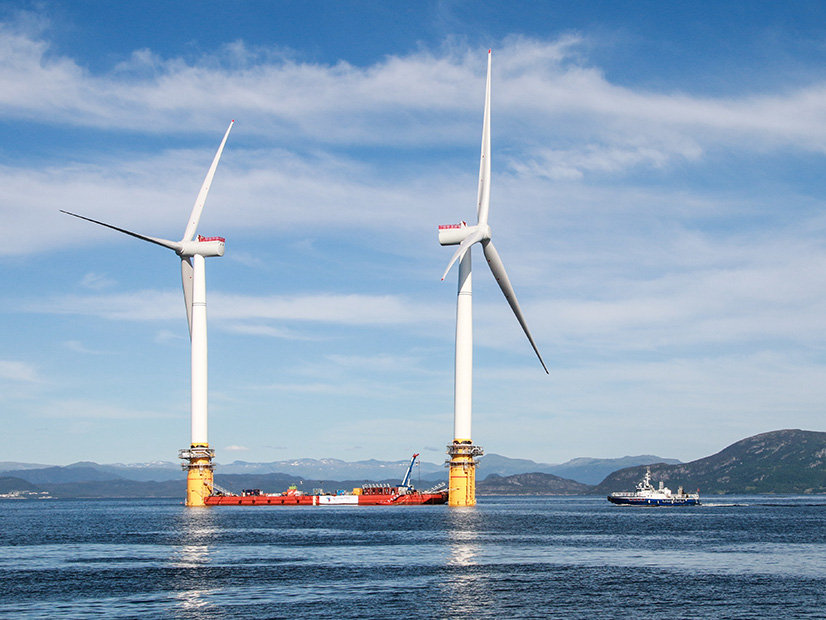The global floating offshore wind (FOSW) development pipeline has grown 228% since the last quarter of 2020, reaching 115.9 GW, according to The Renewables Consulting Group’s 2021 Global Offshore Wind Annual Market Report.
New FOSW capacity that is operational, secured or in development, including capacity that is scheduled for auction, has reached 116.2 GW, the report said. Of the new development capacity, 4.9 GW is attributed to the U.S., where the Bureau of Ocean Energy Management is planning lease auctions in California that would unlock at least 4.5 GW of FOSW capacity.
That planned capacity puts the U.S. eighth in the world in terms of national FOSW pipelines, with the U.K. and Sweden taking the No. 1 and 2 slots at 20.9 GW and 18 GW, respectively.
Industry studies of the global pipeline generally expect between 5 and 12 GW reaching commercial operation by 2030, with the remaining capacity coming online post-2030, Dan Kyle Spearman, director and global lead for floating wind at RCG, told NetZero Insider.
RCG analysis expects that West Coast FOSW projects could come online by 2030. Given the nascent status of the FOSW market, those projects looking to deploy by 2030 will be relying on a growing and risky supply chain.
A lot needs to happen by 2030 for the FOSW market to “pump out the big projects,” Spearman said, including identifying the most cost-effective and reliable floating platforms. “We have a database of over 100 different floating wind platform designs, which is madness.”
The market needs to winnow those designs down to a handful that can use the same supply chain and work in an industrialized, modularized process, he said.
Building a domestic FOSW supply chain for the early West Coast projects will bring a complex set of challenges.
“The West Coast is particularly difficult because you don’t have the history of either big ship building or oil and gas,” like on the south and east coasts, he said. That limits the ability of existing ports to service projects in the near term.
Developers will have to be clever about the construction process, according to Spearman. That might include finding alternatives to the current construction approach that favors erecting turbines on their platforms at port and towing them to the project site.
“It’s quite challenging actually to tow a platform long distances with a turbine fully erected because you get quite significant fatigue in areas such as your tower,” he said. If, for example, construction for Morrow Bay projects were to occur in Humboldt Bay, towing the platform approximately 500 miles to Morrow Bay would test the tower’s structural integrity.
The West Coast’s very deep waters of between 900 and 1,200 meters will also present challenges for the platforms’ mooring system design and required supply chain.
“It’s not insurmountable, but there will be a cost to installation,” Spearman said.
The process of sorting out which of the major platform designs the market will choose to invest in likely will come down to geography, cost and the capabilities of local suppliers.
Designs that are suitable for harsh, deep-water conditions on the U.S. West Coast also might be suitable for projects such as in Australia, Spearman said. Currently, semisubmersible technologies are the “most preferred choice,” but Spearman says he would not rule out a tension-leg-platform (TLP) design. TLP is a “very attractive technology because you can reduce your steel weight,” which is beneficial at scale.
If the U.S. is unable to build a robust domestic FOSW supply chain by 2030, developers will be forced to compete for components internationally against developers in more mature markets.
While there will be a strong opportunity for U.S. domestic component supply to develop, Spearman said, there will be uncertainty about the price point developers will be “willing or forced to pay.”
Ultimately, policy will influence supply chain development and the choice between low-cost energy and a thriving domestic economy.
“Developers can go either way, but if they are left with no policy framework, they’ll just go for the lowest [component] option, and local suppliers are just not going to be able to compete,” Spearman said.
The U.S., he said, will need a policy framework in place to build a joint business case for developers and the supply chain.


